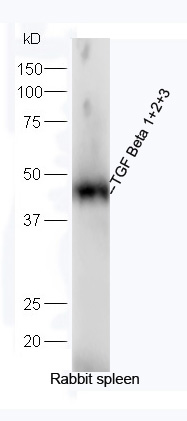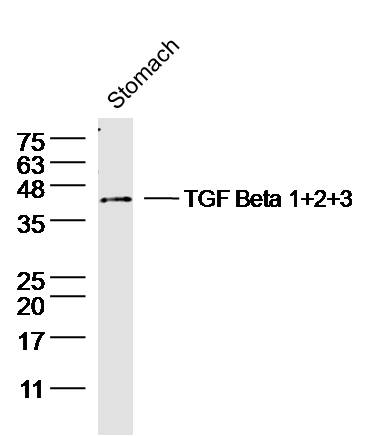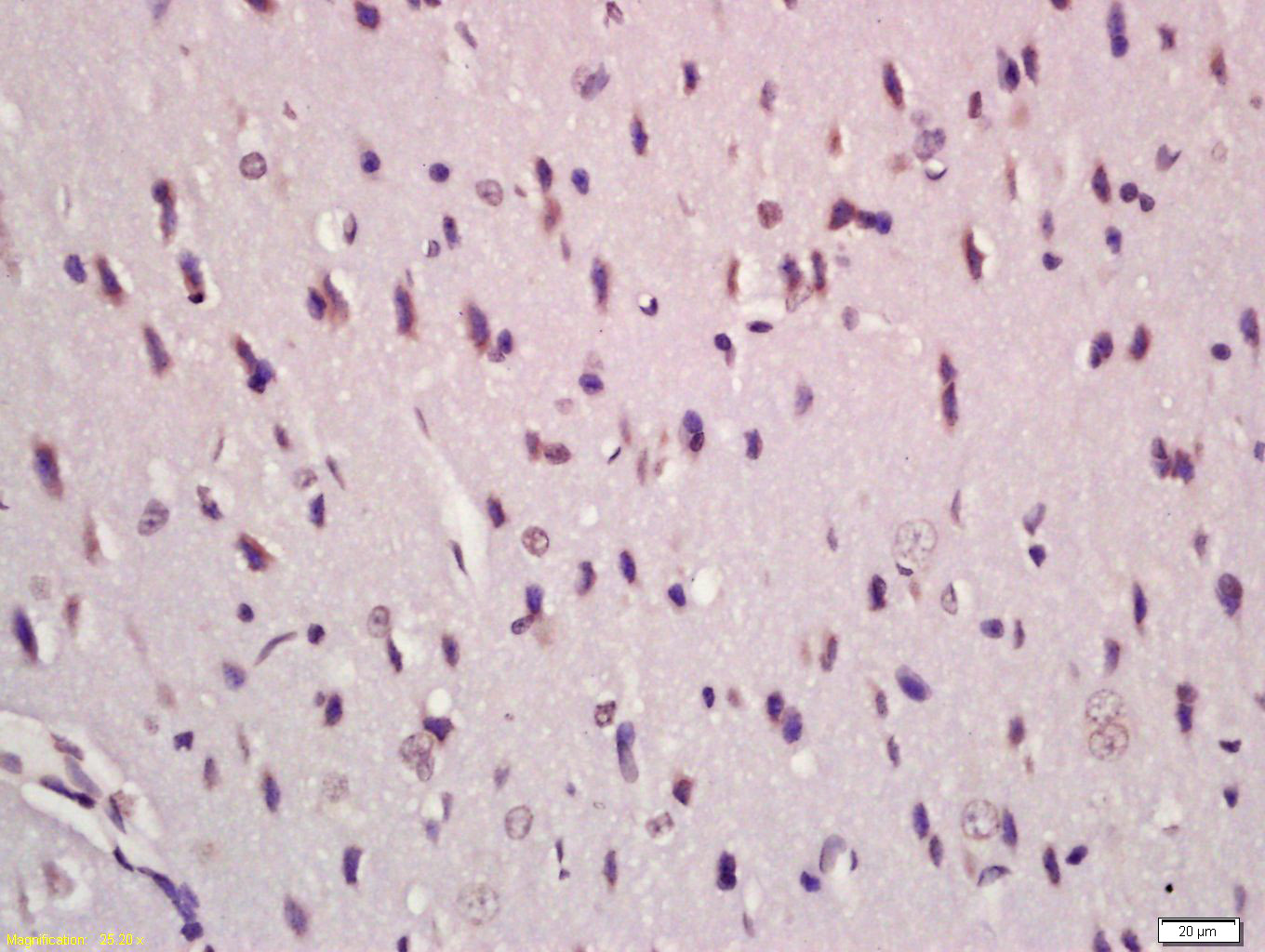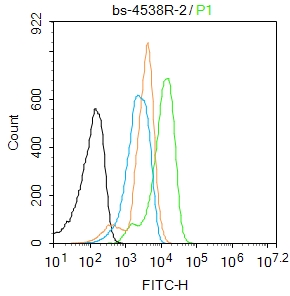
Rabbit Anti-TGF Beta 1+2+3 antibody
TGF Beta 1/2/3; TGFβ1; TGFβ2; TGFβ3; CED; Diaphyseal dysplasia 1 progressive; DPD 1; DPD1; TGF beta 1; TGF beta; TGF beta1; TGF beta2; TGF beta3; TGF-beta 1; TGF-beta 2; TGF-beta 3; TGFB 1; TGFB; TGFB1; TGFB2; TGFB3; Transforming growth factor; Transformi
View History [Clear]
Details
Product Name TGF Beta 1+2+3 Chinese Name 转化生长因子β1抗体 Alias TGF Beta 1/2/3; TGFβ1; TGFβ2; TGFβ3; CED; Diaphyseal dysplasia 1 progressive; DPD 1; DPD1; TGF beta 1; TGF beta; TGF beta1; TGF beta2; TGF beta3; TGF-beta 1; TGF-beta 2; TGF-beta 3; TGFB 1; TGFB; TGFB1; TGFB2; TGFB3; Transforming growth factor; Transforming growth factor beta 1; Transforming growth factor beta 2; Transforming growth factor beta 3; Transforming Growth Factor beta. literatures Research Area Tumour immunology Signal transduction Growth factors and hormones transcriptional regulatory factor Immunogen Species Rabbit Clonality Polyclonal React Species Human, Mouse, Rat, Rabbit, (predicted: Dog, Pig, Cow, Sheep, Guinea Pig, ) Applications WB=1:500-2000 ELISA=1:5000-10000 IHC-P=1:100-500 IHC-F=1:100-500 Flow-Cyt=2μg/Test IF=1:100-500 (Paraffin sections need antigen repair)
not yet tested in other applications.
optimal dilutions/concentrations should be determined by the end user.Theoretical molecular weight 12.8/44kDa Cellular localization Extracellular matrix Secretory protein Form Liquid Concentration 1mg/ml immunogen KLH conjugated synthetic peptide derived from human TGF Beta 1: 301-350/390 Lsotype IgG Purification affinity purified by Protein A Buffer Solution 0.01M TBS(pH7.4) with 1% BSA, 0.03% Proclin300 and 50% Glycerol. Storage Shipped at 4℃. Store at -20 °C for one year. Avoid repeated freeze/thaw cycles. Attention This product as supplied is intended for research use only, not for use in human, therapeutic or diagnostic applications. PubMed PubMed Product Detail The TGFBeta superfamily is composed of numerous growth and differentiation factors, including transforming growth factors Beta(TGFBeta)1,2 and 3; placental transforming growth factor (PTGFBeta);growth /differentiation factors (GDFs); mullerian inhibiting substance (MIS);bone morphogenic proteins (BMPs); glial cell line-derived neurotrophic factor (GDNF);inhibins or activins (Alpha,Beta-A, Beta-B and Beta-C),Lefty and Nodal. Members of the TGF superfamily are involved in embryonic development and adult tissue homeostasis.
Function:
Multifunctional protein that controls proliferation, differentiation and other functions in many cell types. Many cells synthesize TGFB1 and have specific receptors for it. It positively and negatively regulates many other growth factors. It plays an important role in bone remodeling as it is a potent stimulator of osteoblastic bone formation, causing chemotaxis, proliferation and differentiation in committed osteoblasts.
Subunit:
Homodimer; disulfide-linked, or heterodimer with TGFB2. Secreted and stored as a biologically inactive form in the extracellular matrix in a 290 kDa complex (large latent TGF-beta1 complex) containing the TGFB1 homodimer, the latency-associated peptide (LAP), and the latent TGFB1 binding protein-1 (LTBP1). The complex without LTBP1 is known as the'small latent TGF-beta1 complex'. Dissociation of the TGFB1 from LAP is required for growth factor activation and biological activity. Release of the large latent TGF-beta1 complex from the extracellular matrix is carried out by the matrix metalloproteinase MMP3. May interact with THSD4; this interaction may lead to sequestration by FBN1 microfibril assembly and attenuation of TGFB signaling. Interacts with the serine proteases, HTRA1 and HTRA3: the interaction with either inhibits TGFB1-mediated signaling. The HTRA protease activity is required for this inhibition. Interacts with CD109, DPT and ASPN.
Subcellular Location:
Secreted, extracellular space, extracellular matrix.
Tissue Specificity:
Highly expressed in bone. Abundantly expressed in articular cartilage and chondrocytes and is increased in osteoarthritis (OA). Co-localizes with ASPN in chondrocytes within OA lesions of articular cartilage.
Post-translational modifications:
Glycosylated.
The precursor is cleaved into mature TGF-beta-1 and LAP, which remains non-covalently linked to mature TGF-beta-1 rendering it inactive.
DISEASE:
Defects in TGFB1 are the cause of Camurati-Engelmann disease (CE) [MIM:131300]; also known as progressive diaphyseal dysplasia 1 (DPD1). CE is an autosomal dominant disorder characterized by hyperostosis and sclerosis of the diaphyses of long bones. The disease typically presents in early childhood with pain, muscular weakness and waddling gait, and in some cases other features such as exophthalmos, facial paralysis, hearing difficulties and loss of vision.
Similarity:
Belongs to the TGF-beta family.
SWISS:
P01137
Gene ID:
7040
Database links:Entrez Gene: 7040 Human
Entrez Gene: 21803 Mouse
Omim: 190180 Human
SwissProt: P01137 Human
SwissProt: P04202 Mouse
Unigene: 645227 Human
Unigene: 248380 Mouse
Unigene: 40136 Rat
Growth factors and hormones( Growth Factor and Hormones) TGF是一种多效生长因子,对epithelial cells增值有潜在抑制作用,可抑制Tumour生长用于许多恶性Tumour如:胃癌、肺癌、膀胱癌、肾癌、前列腺癌、结肠癌等多种恶性Tumour的研究。 TGFβ超级家族由为数众多的生长的分化因子组成,包括转移生长因子β1,2和3(TGF β1,TGF β2,TGF β3);胎盘生长因子(PTGF-β);生长/分化因子(GDFs);缪氏抑制物(MIS);骨形态形成蛋白(BMPs);交织细胞元神经生长因子(GDNF);抑制素和活化素(α, β-A,和β-C),Lefty和Nodal。 TGF超级家族成员参与胚胎发育和成体组织体内平衡。TGF-β1抗体与TGF-β2和TGF-β3没有React Species。与豚鼠有大部分交叉.Product Picture
Primary: Anti-TGF Beta 1+2+3 (SL4538R) at 1/300 dilution
Secondary: HRP conjugated Goat-Anti-rabbit IgG (SL0295G-HRP) at 1/5000 dilution
Predicted band size: 12.8/44 kD
Observed band size: 44 kD
Sample: Stomach (mouse) Lysate at 40 ug
Primary: Anti- TGF Beta 1+2+3 (SL4538R)at 1/300 dilution
Secondary: IRDye800CW Goat Anti-Rabbit IgG at 1/20000 dilution
Predicted band size: 12.8/44kD
Observed band size: 44 kD
Tissue/cell: rat brain tissue; 4% Paraformaldehyde-fixed and paraffin-embedded;
Antigen retrieval: citrate buffer ( 0.01M, pH 6.0 ), Boiling bathing for 15min; Block endogenous peroxidase by 3% Hydrogen peroxide for 30min; Blocking buffer (normal goat serum,C-0005) at 37℃ for 20 min;
Incubation: Anti-TGF Beta 1+2+3 Polyclonal Antibody, Unconjugated(SL4538R) 1:200, overnight at 4°C, followed by conjugation to the secondary antibody(SP-0023) and DAB(C-0010) staining
Blank control: K562.
Primary Antibody (green line): Rabbit Anti-TGF Beta 1+2+3 antibody (SL4538R)
Dilution: 2μg /10^6 cells;
Isotype Control Antibody (orange line): Rabbit IgG .
Secondary Antibody : Goat anti-rabbit IgG-FITC
Dilution: 1μg /test.
Protocol
The cells were fixed with 4% PFA (10min at room temperature)and then permeabilized with 0.1%PBST for 20 min at room temperature. The cells were then incubated in 5%BSA to block non-specific protein-protein interactions for 30 min at room temperature .Cells stained with Primary Antibody for 30 min at room temperature. The secondary antibody used for 40 min at room temperature. Acquisition of 20,000 events was performed.
References (0)
No References
Bought notes(bought amounts latest0)
No one bought this product
User Comment(Total0User Comment Num)
- No comment






 +86 571 56623320
+86 571 56623320
 +86 18668110335
+86 18668110335

